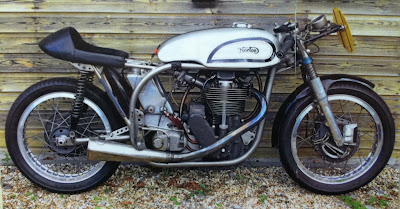I've got mixed feelings on this post, but history cannot be denied. I despise Tritons. They make no sense to me, but I acknowledge their place in the annals of history. There are some false perceptions about the origins of the Triton, which date back to the early 50's when the Manx Norton dominated Gran Prix racing. At the time, Norton wouldn't sell Manx motors separately, and there was some demand for the motors in 500cc Formula racing cars. So, there were some racers that were forced to buy complete Manx Nortons, and then remove the motor for use in their racing cars. Therefore creating discarded complete Manx chassis'. So legend has it that guys started buying up these discarded frames and fitting pre-unit Triumph motors into them. But this is where I believe that the facts of history are incorrect. The question is simple: How many Tritons have you seen, from the period, that were built into Manx frames? The answer is simple - not many. Nearly every original Triton I've ever seen, was built using the road going featherbed frame. But the 2 motorbikes featured in this post, are different, in that they are completely original and were indeed built into Manx frames.
The story apparently starts when, for some unknown reason, Norton refused to sell motorcycles to a man named John Vickers. At some point, he acquired 2 Manx Nortons, or at least their complete chassis', and fitted them with Triumph motors. One being a 500cc, and the other a 650cc. These frames are apparently from 1953, but I'll admit that I know very little about Triumph motors, so I won't dare speak about when these motors are from. Presumably from that same general time period.
The origins of the Triton will always be in debate. The fact is, probably nobody knows. Dave Degens, of Dresda Motors, is often credited with inventing the Triton, but even he's told the story of the first one that he had seen. Recent information seems to point at these JV Specials possibly being the very first of their kind.
This first photo is from a fairly recent motorcycle magazine (I can't recall which magazine or which issue).
And these photos show both bikes at a show in the UK, where they were nicely displayed for all to enjoy. Both bikes appear to have Amal GP carburetors, with the early round type remote float. The longer / slimmer alloy canisters, appear to be chain oilers for the exposed primary.
Interesting to see that John Vickers kept the original Manx paint motif, but changed the black stripe to a blue stripe. And badged each tank with his initials, and the word "Special" underneath them. Forever painting his likeness into a very interesting bit of motorcycle history. That's the kind of thing you can't really get away with these days. Although there are plenty of custom builders rebadging bikes today, I just don't think it's quite the same thing as being the first to start a trend that would be popular 70 years on.
The early 50's Manx Nortons had quite a flat front number plate which was made of metal, and a mesh flyscreen, In this photo, you can see the original Manx swan neck clip ons, as well as the upper fork shroud cutouts to accommodate the short / manx length forks.
All the typical early featherbed Manx features - twin leading shoe magnesium front brake, early type upright rear shocks and conical Manx rear hub. I bet the open meggas sound quite nice, and they damn sure look good painted black.
The best thing about these machines is that they're now in the hands of an owner that's smart enough to appreciate their original patina. Countless bikes get dragged out of sheds for the first time in decades, only to be restored or even worse, over-restored. Thankful for all of us that these 2 important machines haven't suffered the same fate. And it's nice to see that he still brings them out for the public to see, and apparently even runs them from time to time.
The story is that the 500cc machine ran at the Isle of Man TT, but I've yet to be able to confirm when that happened, or what result it garnered. The 650cc machine wouldn't have been eligible at the TT, but apparently competed in other road racing events around the UK and Europe. At some point in the late 1950's they were tucked away in a shed, and sat dormant for 50 years or so.
I'll admit that these bikes are absolutely stunning. But I'll also state that what I find beautiful about them, is all the Norton bits. I could care less about the Triumph motors, but I fully acknowledge the importance of these machines. John Vickers must have been an interesting guy. Or maybe he was just lucky and had no idea what he had started. One thing is for sure, anyone building a Triton, should take a close look at these and follow suite. The world certainly doesn't need another slimline featherbed with a Triumph unit motor.






























.JPG)
.jpg)
.jpg)
.jpg)
.JPG)









